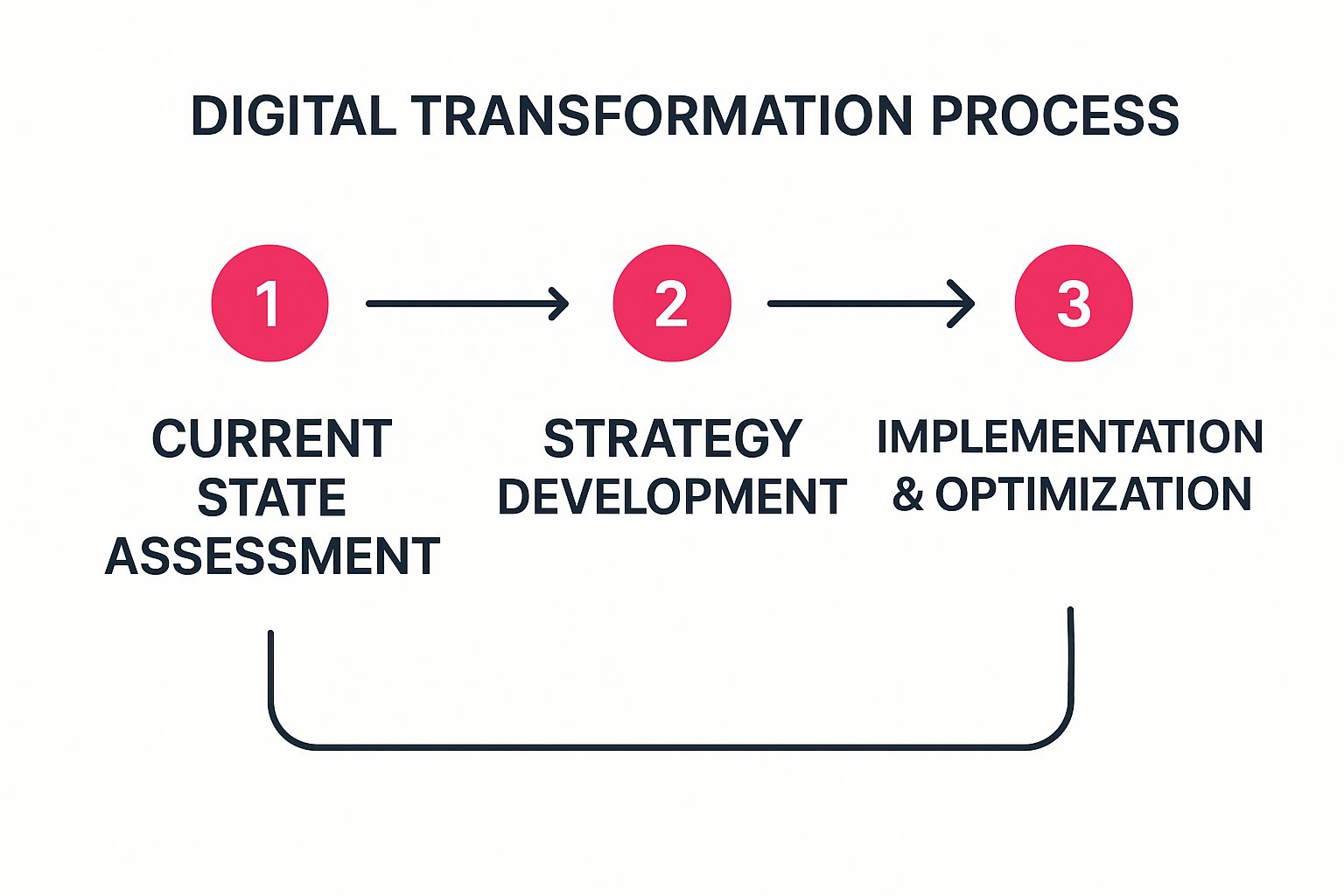So, what exactly is digital transformation consulting? It's easy to get lost in the buzzwords, but at its core, this is a specialized service designed to help a company fundamentally rethink its business for the digital age. It's not just about installing the latest software or moving to the cloud. It's a true strategic partnership aimed at reinventing how a company operates, serves its customers, and ultimately, wins in a modern economy.
What Is Digital Transformation Consulting?

Think of your company as a classic, dependable sailing ship. It's served you well, but it's not built for the speed and agility needed today. You need to upgrade it into a modern, high-tech vessel, but here's the catch—you have to do it while you're still sailing.
That's where a digital transformation consultant comes in. They are the expert naval architects and engineers who come aboard to manage this complex overhaul without capsizing the ship. They bring an essential outside perspective, helping you re-evaluate everything from your engine room (operations) to your navigation charts (strategy).
These consultants work alongside you to overhaul core functions. It’s a holistic process that goes far beyond a simple IT refresh; it touches every single part of the organization.
The Core Focus of a Consultant
A good digital transformation consultant doesn't just hand you a list of tech products. Their real job is to create a detailed blueprint for survival and long-term growth. They focus on bringing together the critical pieces of the puzzle, as shown in the table below.
Core Focus Areas of Digital Transformation Consulting
| Pillar of Transformation | Consultant's Role & Objective | Example Initiative |
|---|---|---|
| Strategy & Vision | Align digital goals with overall business objectives. Ensure every action is purposeful and drives real, measurable results. | Developing a 3-year roadmap that prioritizes digital projects based on their expected ROI and market impact. |
| Process Re-engineering | Analyze and redesign outdated workflows. Make operations more efficient, automated, and data-informed. | Implementing a new CRM system that automates lead nurturing and provides the sales team with real-time customer insights. |
| Technology Implementation | Identify, vet, and integrate the right tools (AI, cloud, etc.) to unlock new business capabilities. | Migrating legacy data systems to a scalable cloud infrastructure to improve data accessibility and security across the company. |
| Change Management | Guide employees through the transition. Nurture a company culture that embraces digital tools and continuous improvement. | Creating a training program and internal communications plan to help the finance team adopt a new automated invoicing platform. |
Ultimately, the consultant's job is to connect the dots. They navigate the intricate connections between your people, your processes, and your technology to get you from where you are to where you need to be.
A Rapidly Growing Field of Expertise
The demand for this kind of expert guidance is absolutely skyrocketing. This is especially true in regions like the Middle East, where economic diversification is a top government priority.
By 2025, the Digital Transformation Consulting Services market in the Middle East is on track to hit an incredible $2.421 billion, which is a 63.86% jump from 2021. And it's not stopping there. Forecasts predict the market will balloon to nearly $5.923 billion by 2033.
This massive investment highlights a critical business truth: successful change doesn't happen by accident. To build a solid foundation for your own journey, you need a well-defined digital transformation strategy that steers every decision. A consultant's primary role is to help you build and execute that very strategy, turning your ambition into real-world results.
Why Your Business Needs an Expert Outside Perspective

Many leaders believe they have the right people in-house to navigate their own digital shift. While that confidence is great, trying to go it alone often results in big, expensive mistakes. The truth is, genuine transformation demands a fresh perspective—one that’s almost impossible to find from inside the company walls.
Think about it. Your internal team is deep in the weeds of daily operations. They’re caught up in company politics and shaped by years of doing things "the way we've always done them." This is precisely where digital transformation consulting proves its worth. An outside expert brings a critical, objective eye.
Free from legacy thinking and internal biases, their only mission is to identify the real challenges and build solutions that work. They can see the blind spots and roadblocks your own people might miss or, frankly, be too hesitant to point out.
Unlocking Specialized Expertise and Accelerating Change
One of the biggest reasons to hire a consultant is to get immediate access to specialized skills. The technologies that power a modern business—AI, sophisticated data analytics, scalable cloud systems—are incredibly complex and change at lightning speed. Most companies just don't have that kind of deep, current expertise on the payroll.
Consultants, on the other hand, live and breathe this stuff. They've seen what succeeds and what fails across countless industries and business models. This hands-on experience lets them deploy the right tools much faster and more effectively than an internal team that’s forced to learn on the fly.
An external partner is a catalyst. Their very presence creates urgency and accountability, driving projects forward when they might otherwise get bogged down by internal priorities or simple organizational inertia.
This ability to speed things up is crucial. A Gartner study revealed that 56% of CEOs saw digital improvements directly boost their revenue, highlighting just how important it is to get it right and get it done quickly.
De-Risking Your Investment and Driving Measurable Outcomes
Digital transformation projects are major investments. Without an experienced guide, they can quickly become costly experiments with no clear payback. A consultant’s main job is to de-risk that investment by making sure every action is tied to a measurable business outcome.
They don’t just bring technology; they bring a structured approach. The goal is to ensure technology serves a clear purpose, like:
- Improving Operational Efficiency: Automating repetitive tasks to slash costs and let your team focus on more strategic work.
- Enhancing Customer Experience: Using data to build personalized interactions that create loyal customers.
- Increasing Market Share: Launching new digital products or services to tap into fresh revenue streams.
This sharp focus on ROI turns a vague idea into a powerful engine for growth. The demand for this kind of expertise is surging for a reason. In 2023, the Middle East and Africa Digital Transformation Consulting Market was valued at roughly $14.76 billion. It's expected to grow at a compound annual rate of 25.86% through 2029, fueled by massive regional investments in technology and sustainability.
Ultimately, hiring an outside expert is a strategic move to ensure your transformation delivers. For more on the value an external partner can bring, check out these insights on Top Business Transformation Consultants. They provide the impartial oversight, deep knowledge, and focused execution needed to turn ambitious digital goals into real-world results.
The Consulting Journey: From Strategy to Scale
Working with a digital transformation consulting firm isn't a single transaction; it's a journey. Think of it as a guided expedition, moving your business from its current state to a future where it can genuinely thrive and adapt. The process is broken down into clear, logical phases to make sure nothing gets missed.
It all follows a phased approach, ensuring a solid foundation is built before moving on to the next step. This visual gives a great high-level overview of the flow, from initial assessment all the way to ongoing improvement.

As you can see, a successful transformation starts with a deep understanding of the business. Only then can you move into smart planning and continuous growth.
Discovery and Strategy Formulation
The first phase is all about deep-dive discovery. Your consultants will act like business detectives, digging into every corner of your operations to understand what makes your company tick. They’ll interview key stakeholders, map out existing workflows, and audit your current technology. The goal here is to diagnose the real challenges and uncover opportunities you might not even see.
This isn't just about finding problems, though. It's about creating a shared vision for the future. The most important outcome of this stage is a clear, unified answer to the question: "Where are we today, and where do we really need to be?"
This process generates a mountain of information. To make sense of it all, consultants have to lean heavily on data. In fact, mastering data analysis for marketing and operations is what separates a generic plan from one that will actually hit the mark. It helps them pinpoint specific customer behaviors and operational bottlenecks that are holding you back.
Roadmap and Solution Design
Once the strategy is clear, the next step is to turn that grand vision into a practical, step-by-step plan. This is where the "what" and "why" become the "how" and "when." The consulting team gets to work designing a detailed roadmap that outlines specific projects, realistic timelines, and clear budgets.
But a roadmap is so much more than a project schedule. It’s a strategic blueprint that prioritizes initiatives based on their potential impact and how achievable they are. This phase typically includes:
- Technology Selection: Identifying and vetting the right software, platforms, and tools—like AI, cloud services, or a new CRM system—that will help you reach your goals.
- Process Redesign: Mapping out new, streamlined workflows that cut out the fat and make the most of your new technology.
- Metric Definition: Nailing down the key performance indicators (KPIs) you'll use to measure success and track your return on investment (ROI).
A well-designed roadmap ensures every dollar spent and every hour invested is tied directly to a specific business outcome. It turns ambitious goals into a series of manageable, executable steps.
Implementation and Change Management
With a solid plan in hand, it's time to roll up your sleeves and get to work. The implementation phase is where new technologies are deployed, processes are updated, and the real transformation begins. Consultants often step into a project management role here, coordinating between your internal teams and outside vendors to keep everything on track.
But getting the tech right is only half the battle. A staggering 70% of transformation initiatives fall short of their goals, and it's almost always because of resistance from employees. This is why change management is absolutely crucial. Consultants work to get your team on board by:
- Communicating the Vision: Clearly and consistently explaining the "why" behind the changes to get everyone excited and motivated.
- Providing Training: Giving your people the skills and confidence they need to actually use the new tools effectively.
- Establishing Support Systems: Creating easy ways for employees to give feedback and get help when they feel stuck.
Optimization and Continuous Evolution
Digital transformation isn’t a one-and-done project. The final phase is about building a culture of continuous improvement that sticks around for the long haul. After the initial rollout, consultants help you measure the results against the KPIs defined in the roadmap. This data-driven feedback loop is what allows you to refine your strategy over time.
Ultimately, this stage is about making your organization more agile and self-sufficient. The goal is to empower your own team to keep optimizing processes and adapting to whatever the market throws at them, long after the consulting engagement has wrapped up. This is what ensures your transformation delivers lasting value and a real competitive edge.
The Tech That Makes Modern Business Tick
A great strategy is one thing, but you need the right tools in the toolbox to actually bring it to life. When we talk about digital transformation, we're really talking about a handful of core technologies that are changing how business gets done. These aren't just buzzwords; they're powerful instruments that, when you know how to use them, can give you a serious competitive edge.
The Foundation: Cloud Computing
Almost every digital initiative today starts with Cloud Computing. Think of it as the new, flexible engine for your business. Instead of being locked into the expensive, clunky servers in your back office, the cloud gives you instant access to all the computing power, storage, and software you could ever need, right when you need it. This shift is a game-changer.
This newfound agility means you can scale your services up or down at a moment's notice to meet customer demand—something that was once unthinkable with traditional IT. It’s no surprise that a recent survey found 86% of businesses see cloud technology as absolutely critical to their transformation efforts. It's the bedrock of a truly responsive and resilient company.
The Brains of the Operation: AI and Machine Learning
Sitting on top of that cloud foundation, you have Artificial Intelligence (AI) and Machine Learning (ML). If the cloud is the engine, these are the brains, turning raw data into smart decisions. Instead of just letting information sit in a database, AI and ML algorithms sift through it to spot patterns, predict what’s coming next, and even automate complex tasks.
For example, an e-commerce site can use ML to look at what a customer has browsed and instantly recommend other products they'll probably love. This isn't just a gimmick; it creates a genuinely personal experience that drives sales and keeps people coming back. On the backend, AI can take over tedious administrative work, freeing up your team to focus on work that actually requires a human touch.
The Fuel: Data Analytics
So what fuels this entire machine? Data Analytics. In this economy, information is your most valuable asset, but only if you can make sense of it. A huge part of any transformation project is building the capability to collect, process, and understand data from every part of your business.
This means getting beyond basic sales reports and developing a full 360-degree view of your customers and your operations. This is what truly separates the leaders from the laggards. A Deloitte report found that the most digitally mature companies saw 45% revenue growth, largely because they made smarter decisions backed by data.
The real goal here is to build a culture where decisions are guided by evidence, not just gut feelings. This is how data stops being a simple byproduct and starts being the active driver of your entire strategy.
Connecting a Digital Strategy to the Real World
Two other key pieces of the puzzle are the Internet of Things (IoT) and Blockchain. IoT is all about embedding sensors into physical things—from factory machinery to delivery trucks—to collect data in real time. A logistics company, for instance, can use IoT sensors to track its fleet, fine-tuning routes on the fly to save fuel and get packages delivered faster.
Blockchain, famous for powering cryptocurrencies, is really a super-secure, transparent ledger. In a supply chain, it can create an unbreakable record of a product's journey from the farm to the store shelf, which builds incredible trust and accountability. While these technologies are a bit more specialized, they can solve some incredibly tough business problems when applied correctly.
Of course, the right technology isn't one-size-fits-all. A detailed IT services healthcare transformation guide, for example, shows how tailored tech solutions can completely reshape patient care. The key is working with an expert in digital transformation consulting to pick the right mix of tools to build a business that’s ready for whatever comes next.
How to Choose the Right Consulting Partner

Let's be blunt: choosing the right digital transformation consulting partner is probably the most critical decision you'll make in this entire process. It will have a far greater impact on your success than any specific technology you choose.
Get this right, and you’ll have a true extension of your team. Get it wrong, and you're looking at wasted money, stalled projects, and a whole lot of frustration. You need to look beyond the slick sales pitch and use a practical playbook to find a firm that has the right skills and fits your company's culture.
Look for Proven Industry Experience
First things first: your partner absolutely must understand the world you live in. A firm that delivered amazing results for a retail company might not grasp the tough regulatory landscape of finance or the intricate operational hurdles in manufacturing. One-size-fits-all just doesn't cut it here.
You’re looking for a consultant with a real, verifiable track record in your specific industry. This is more than just knowing the buzzwords. It’s about a deep, practical understanding of your market, your customers' expectations, and the competitive pressures you face daily.
A consultant with genuine industry expertise can see challenges coming before they hit. They bring ready-made frameworks and valuable lessons from solving similar problems for companies just like yours, which can shave months off your timeline.
When you talk to them, they should sound less like a tech vendor and more like a seasoned expert from your own field. That depth of knowledge is what separates a good consultant from a truly great one.
Scrutinize Case Studies for Real Impact
Every consulting firm has a stack of impressive-looking case studies ready to go. Your job is to dig past the glossy success stories and find hard evidence of measurable impact. Don't let vague claims like "improved efficiency" or "enhanced engagement" slide.
Instead, ask for concrete metrics that matter to your bottom line.
- For Sales Growth: "We boosted online sales conversion rates by 22% in six months by redesigning the e-commerce checkout."
- For Operational Efficiency: "Our automated invoicing system cut accounts payable processing time by 40 hours per week, saving the company over £40,000 a year."
- For Customer Retention: "By rolling out a new CRM and personalized messaging, we lowered customer churn by 15% year-over-year."
Pushing for this level of detail forces a firm to prove its worth. It also gives you a much clearer idea of the kind of results you can realistically expect.
Assess Cultural Fit and Collaboration Style
This is the one factor everyone underestimates, but it’s often what makes or breaks a project. These consultants will be working shoulder-to-shoulder with your people for months, maybe even years. If their working style clashes with your company culture, you’re in for a rough ride.
Think about what you really need. Do you want a partner who takes charge and drives the project forward? Or do you need a more collaborative guide who focuses on empowering your internal team? There’s no right answer, but there is a right fit for your organization. As this article explains, choosing the right creative partner makes all the difference, and the same logic applies here.
To get a feel for this, ask some direct questions during your evaluation:
- How do you handle disagreements or pushback from our internal teams? (This reveals their approach to conflict.)
- Describe your ideal client relationship. What do you need from us to succeed? (This shows if they view you as a partner or just another contract.)
- How will you work to transfer knowledge and skills to our employees? (This tests their commitment to making you self-sufficient.)
Ultimately, you want a firm that acts more like a coach than a contractor. A great partner is focused on building up your team’s skills so you can keep innovating long after they’re gone.
Consulting Partner Evaluation Checklist
Finding that perfect-fit partner requires a structured approach. Use this checklist to compare your options and ensure you’re not missing any crucial details. It helps turn a gut feeling into a data-backed decision.
| Evaluation Criterion | What to Look For | Key Questions to Ask |
|---|---|---|
| Industry Expertise | Deep, verifiable experience in your specific market sector. | "Can you share 2-3 case studies from our industry? What were the specific challenges and results?" |
| Technical Skills | Proven ability with the technologies relevant to your project (e.g., cloud, AI, data analytics). | "What's your team's experience with [specific platform/tool]? Can we speak to your technical lead?" |
| Measurable Impact | Case studies with clear, quantifiable business outcomes (e.g., revenue, cost savings, efficiency gains). | "For that project, what was the exact ROI? How did you measure the 15% decrease in churn?" |
| Cultural Fit | A collaborative style that aligns with your company's values and way of working. | "How do you handle project disagreements? How do you integrate with a client's team?" |
| Strategic Vision | Ability to think beyond the immediate task and contribute to your long-term business goals. | "How does this project fit into our broader business strategy? What are the risks we haven't considered?" |
| Knowledge Transfer | A clear plan for training and upskilling your internal team to ensure long-term success. | "What's your methodology for training our staff? What does success look like when the project is over?" |
After you've scored each potential partner against these criteria, you'll have a much clearer picture of who is truly equipped to guide your journey. By carefully evaluating experience, results, and cultural fit, you can find a digital transformation consulting partner who will be a genuine catalyst for your success.
Navigating Common Transformation Roadblocks
The path to a full digital overhaul is rarely a straight line. Think of it less like a newly paved highway and more like an off-road adventure. It's an exciting journey, but it’s almost guaranteed to have some predictable bumps and obstacles that can stop even well-funded projects in their tracks. This is where an experienced digital transformation consulting partner really earns their keep—they’ve driven this route before and know how to anticipate and navigate these challenges.
Knowing what roadblocks to expect is half the battle. When you can see the pitfalls coming, you can turn a potential crisis into a chance to build a stronger, more adaptable team and fine-tune your strategy.
Overcoming Employee Resistance
One of the most common and toughest hurdles isn’t technical—it’s human. The very people you’re trying to empower with new technology are often the most resistant. Change is uncomfortable, and introducing new software and workflows can stir up fears of being replaced, frustration with steep learning curves, or just general anxiety about the unknown. In fact, a staggering 70% of transformation initiatives fall short of their goals, and most of that comes down to people-related friction.
The solution is a solid change management plan, which is much more than just a company-wide email announcement. It needs to be a core part of the project from day one. This involves:
- Consistent Communication: You have to relentlessly explain the "why." People need to clearly see how these new tools will make their work-life better and more effective, not just different.
- Visible Leadership Buy-In: It’s one thing to hear about change; it’s another to see it in action. When leaders, from the C-suite to team leads, are actively using and promoting the new systems, it sends a clear signal that this change is real, important, and here to stay.
- Hands-On Training: Effective, role-specific training is non-negotiable. It builds competence and confidence, stamping out the frustration that breeds resistance.
A great consultant acts as the conductor for this human-centric orchestra, ensuring people are always at the heart of the strategy, not a footnote.
Tackling Technical Hurdles
Of course, the technical challenges are very real. Many businesses are held back by legacy systems—those old, clunky platforms that just weren't built to talk to modern cloud tools. This creates a messy web of information silos, trapping valuable data within individual departments and making it impossible to get a clear, single picture of the business.
Here are the key technical knots a consultant helps untangle:
- Integrating Legacy Systems: They find clever ways to build bridges (like custom APIs or middleware) between your old and new software. This lets them communicate without forcing you into a hugely expensive and disruptive "rip-and-replace" project.
- Breaking Down Data Silos: The goal is to create a central source of truth. This could be a structured data warehouse or a more flexible data lake where information from every corner of the company can be pooled, accessed, and analyzed.
- Ensuring Data Security: Making data more accessible also makes it more vulnerable. Consultants are essential for implementing tough security protocols and governance rules to protect your most sensitive information as it flows through these new channels.
Getting the technology right isn't just about plugging things in so they work. It's about building a seamless digital nervous system for the entire company. This is the foundation that allows you to finally make decisions based on real data, not just gut feelings.
Maintaining Momentum and Budget Support
Big projects always kick off with a lot of buzz and excitement. But as the weeks turn into months, that energy can start to fade, especially if results aren't immediately obvious. Impatient leaders and budget holders might start questioning the investment, which can lead to pulled funding—a death sentence for any transformation effort.
To keep the project alive and thriving, a smart consultant focuses on delivering quick, visible wins. By prioritizing smaller initiatives that produce tangible results early on—things like a clear drop in operational costs or a measurable jump in a customer satisfaction score—they prove the project's value. These early victories build momentum and keep stakeholders confident, ensuring you have the long-term support and resources needed to cross the finish line.
Got Questions? Let's Get Practical.
When you're considering a digital transformation project, the big, practical questions start to surface. How long will this take? What’s it going to cost? And most importantly, how do we know if it’s actually working? Before you dive in, you need clear answers. Let's tackle some of the most common questions we hear from leaders just like you.
One of the first things everyone wants to know is the timeline. "How long does a digital transformation project take?" The honest answer? It's a journey, not a quick fix. A more contained project, like launching a new CRM system, might wrap up in six to nine months. But if you're talking about a complete overhaul that touches multiple parts of your business, you're looking at a multi-year commitment. These larger projects are always broken down into manageable phases to keep things stable and show progress along the way.
Is This Just a Fancy IT Upgrade?
It’s easy to get these two mixed up, but they're fundamentally different. An IT upgrade is tactical. Think of it as swapping out an old part for a new one, like getting new servers or updating your software. It improves a tool, but it doesn't change the game.
Digital transformation is strategic. It’s about rethinking how your business actually runs, how you make money, and how you connect with your customers. Technology is the engine for this change, not just the shiny new object you install. It’s about rewiring your core processes and, often, your company culture itself.
How Do You Actually Measure Success?
So, how do you measure the return on this kind of investment (ROI)? Any consultant worth their salt will skip the fluffy promises and get straight to the numbers. They should work with you to pinpoint clear, trackable metrics that connect directly to your bottom line.
Success isn't just about launching new technology; it's about achieving measurable business outcomes. The goal is to tie every initiative to tangible improvements that leaders can see, track, and report on.
A good partner will help you build a scorecard with a mix of metrics to get a complete picture. This usually includes:
- Operational Efficiency: Are you seeing a drop in the time it takes to complete tasks or a reduction in manual work?
- Revenue Growth: Are sales, conversion rates, or customer lifetime value on the rise?
- Customer Satisfaction: Are you seeing better Net Promoter Scores (NPS) or are more customers sticking around?
- Employee Productivity: Is your team getting more done? Are new hires getting up to speed faster?
At Grassroots Creative Agency, we believe a successful digital strategy is built on clear goals and measurable results. We partner with you to turn ambitious ideas into impactful realities. Find out how we can guide your digital growth journey.








